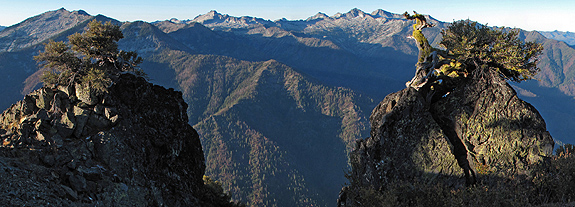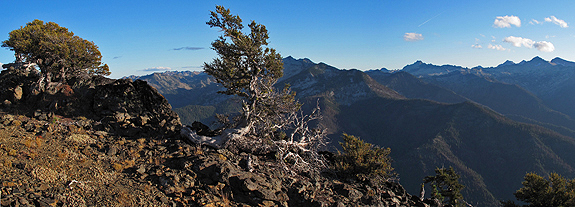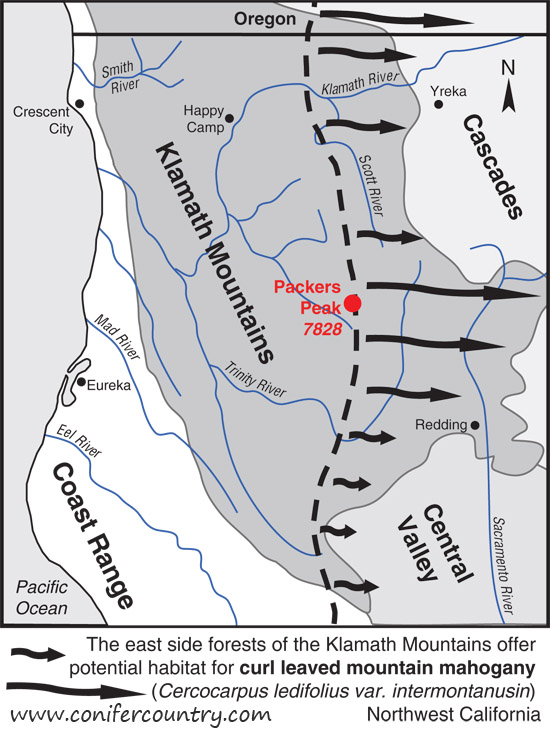Original Publication DATE: 9/22/2009
High above the headwaters of the Salmon River and Coffee Creek, the remarkable ascension of Packers Peak is surprising next to the seemingly superlative granite of the Alps. The peak is a pedestal on which to perch, understand, and enjoy the complex Trinity Alps Wilderness that surrounds you. It is a steep climb from Big Flat, at the end of Coffee Creek Road, to reach this vantage point; but if you are willing to climb the nearly 3,000 feet in just under 3 miles, you will be rewarded.

The hike begins in Douglas-fir/white fir forest switchbacking through long forgotten gold mines. It gradually transitions to Jeffrey pine/sugar pine/incense-cedar forest with an understory of greenleaf manzanita (Arctostaphylos patula) as the trail becomes exposed on the south-face of Packers Peak. Finally, after nearly 2.5 miles of steep climbing, botanical cues hint that you are reaching the high country–as the first foxtail pines appear along with Shasta fir and mountain hemlock. Audible cues occur as well, with the robotic squawk of Clark’s nutcrackers (Nucifraga columbiana) one understands that unique food opportunities are provided by the rare foxtail pine–something that the nutcrackers take advantage of. In the final ascent to the summit, there are certain south-facing, wind-swept, precipitous outcrops of rock on which even hearty conifers cannot take purchase–this is the habitat on which curl leaved mountain mahogany thrives.

Cercocarpus ledifolius is widely distributed in arid western North America. From Baja California north to Montana and east from Nebraska to its western extent near the Pacific Ocean (Ross). The species thrives in dry, hot environments typical of what high deserts in the West have to offer. In the Klamath Mountains, this species reaches the western extent of its range–roughly along a crest which creates a subtle rain shadow. This divide (also quite often the Siskiyou/Trinity County line) separates the temperately moist west side forests from the more arid east side forests. This biogeographic pattern is consistent with several other species that are synonymous with curl leaved mountain mahogany in the arid West–like western juniper (Juniperus occidentalis) or western sagebrush (Artemisia tridentata)–which also reach the western extent of their range in the eastern Klamath Mountains.
What my wife and I found most interesting about the flora of Packers Peak was the intermingling of the curl leaved mountain mahogany with some of the subalpine conifer species–particularly the foxtail pines. In my extensive wanderings across the Klamath Mountains (often specifically to seek out groves of foxtail pine) I only remember one other time where the range of these two species overlapped, that time was on the way to the top of Mount Eddy. This is quintessential Klamath complexity–within this ancient meeting ground it is rare to find any sort of typical plant distribution–where surprises often come with every twist of the trail. The top of this mountain is the divide between the Siskiyou and Trinity Counties–and Packers Peak is one of the few place to find Cercocarpus ledifolius in Trinity County. But just barely…

Because of my affinity for conifers I will also include the species we recorded on our hike to Packers Peak:
- ponderosa pine (Pinus ponderosa)
- Jeffrey pine (Pinus jeffreyi)
- sugar pine (Pinus lambertiana)
- western white pine (Pinus monticola)
- whitebark pine (Pinus albicaulis) *only one small tree
- lodgepole pine (Pinus contorta)
- foxtail pine (Pinus balfouriana)
- Shasta fir (Abies magnifica var. shastensis)
- white fir (Abies concolor)
- Douglas-fir (Pseudotsuga menziesii)
- mountain hemlock (Tsuga mertensiana)
- incense-cedar (Calocedrus decurrens)

Resources:
- Ross, Christopher. Curl Leaved Mountain Mahogany. accessed 9-22-3009

One Reply to “Packers Peak – Trinity Alps Wilderness”
Comments are closed.